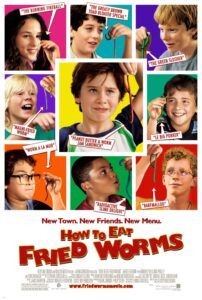Celebrating its 50th anniversary, How to Eat Fried Worms remains a memorable title for many who grew up in the chapter book era. Alongside classics like Bunnicula and Sideways Stories from Wayside School, Thomas Rockwell’s tale of a boy accepting a worm-eating dare captured the imaginations of young readers. Revisiting this book prompts a look back at its enduring appeal, its controversies, and how it fares today, especially when considering the 2006 movie adaptation. What makes this story resonate, and did the movie capture the quirky spirit of the book, or did it, well, just worm its way into something less palatable?
The Book’s Enduring Charm and Unexpected Controversies
For those unfamiliar, How to Eat Fried Worms centers on Billy, a young boy who accepts a bet to eat fifteen worms in fifteen days for $50. This simple premise unfolds into a humorous exploration of childhood dares, rivalry, and the surprising adaptability of taste buds. Rereading it as an adult, the book’s quaint charm is evident. It’s a story driven by the playful antagonism between Billy and his antagonist, Alan, with Billy’s friend Tom acting as a loyal second. This dynamic creates a classic battle of wits, reminiscent of childhood games played out over long summer days.
The book evokes a strong sense of nostalgia, particularly for Gen-X and elder Millennial readers. It portrays a world of unsupervised children, free to roam outdoors and engage in low-stakes adventures. The mention of a minibike as the prize for Billy’s wager further grounds the story in a specific era, likely prompting some readers to recall a time when such vehicles were the pinnacle of youthful aspirations. Even the brief reference to a raccoon coat sparks a sensory flashback to a bygone era, adding layers of historical and cultural context for older readers.
However, How to Eat Fried Worms isn’t without its complexities. Surprisingly, the book has been frequently challenged, appearing on the American Library Association’s list of challenged books. The reasons cited include the promotion of gambling (due to the bet) and the depiction of eating earthworms as “antisocial behavior.” While the gambling aspect might seem like a stretch, the concern over “antisocial behavior” highlights a somewhat xenophobic viewpoint. Eating worms is a practice found in various cultures around the world, and to label it as inherently antisocial reveals a narrow perspective. This controversy underscores the sometimes exhausting nature of book banning debates and the often-unfounded fears that drive them.
Questionable Elements and Gender Dynamics
Beyond the challenged book status, some elements of How to Eat Fried Worms warrant a more critical look. One recurring theme that feels dated is the portrayal of gender roles. The book tends to depict women, particularly mothers, as prone to overreaction and anxiety, while fathers embody calm reason and permissiveness. This stereotype, though perhaps reflective of some societal norms of the time, is a disappointing aspect of the narrative. Similarly, casual instances of fatphobia appear in the book, which, while unfortunately not uncommon in literature even today, detract from the reading experience.
Another element that feels particularly jarring in retrospect is the series of chapter titles that draw comparisons between Billy’s group and American forces in World War II, and Alan’s group and the Japanese. This analogy is not only inappropriate but also reflects a simplistic and potentially harmful way of framing childhood conflicts. This aspect of the book, in particular, sits uncomfortably with modern sensibilities and raises questions about the cultural context in which the book was written and received.
The Movie Adaptation: Lost in Translation?
 How To Eat Fried Worms movie
How To Eat Fried Worms movie
The 2006 movie adaptation of How to Eat Fried Worms attempts to bring the story to a new audience, but unfortunately, it largely misses the mark. Devoid of the book’s subtle charm and wit, the film opts for broad, often crude humor and slapstick comedy. The clever battle of wits between Billy and Alan is replaced with a series of gross-out gags, diluting the original narrative’s appeal.
Furthermore, the movie exacerbates some of the book’s weaker points while adding new problematic elements. The gender politics, already questionable in the book, seem even more pronounced in the film. The addition of a token female character, who primarily serves to solve problems for the male protagonist without having her own distinct storyline, reinforces stereotypical gender roles. This portrayal is arguably more frustrating than the book’s depiction of the “hysterical mom,” highlighting a missed opportunity to modernize the story in a positive way.
Adding to the film’s missteps is its questionable depiction of “ethnic” foods. Scenes that portray burritos and Chinese takeout as disgusting feel culturally insensitive and unnecessary, further detracting from the viewing experience. While the movie does include the upbeat track “Move Your Feet” by Junior Senior and features a young Hallie Eisenberg (of Pepsi commercial fame), these small positives are hardly enough to redeem the film’s overall shortcomings.
Final Thoughts: Book vs. Movie and Modern Relevance
While How to Eat Fried Worms the book holds a nostalgic place for many and possesses a certain quaint charm, it is not without its flaws. Its gender stereotypes and cultural references feel dated and problematic when viewed through a contemporary lens. However, the book’s core humor and exploration of childhood dynamics still resonate to some extent.
The How to Eat Fried Worms movie, on the other hand, largely fails to capture the spirit of the book. Its reliance on gross-out humor, weaker characterizations, and amplified problematic elements make it a disappointing adaptation. For those seeking engaging chapter books for young readers today, it’s advisable to explore the wealth of contemporary children’s literature available. While revisiting childhood favorites can be enjoyable, focusing on books that reflect current values and diverse perspectives is ultimately more enriching for young readers. How to Eat Fried Worms might be a nostalgic trip, but it’s a journey best appreciated with a critical eye, and perhaps, better left as a book than revisited through its movie adaptation.